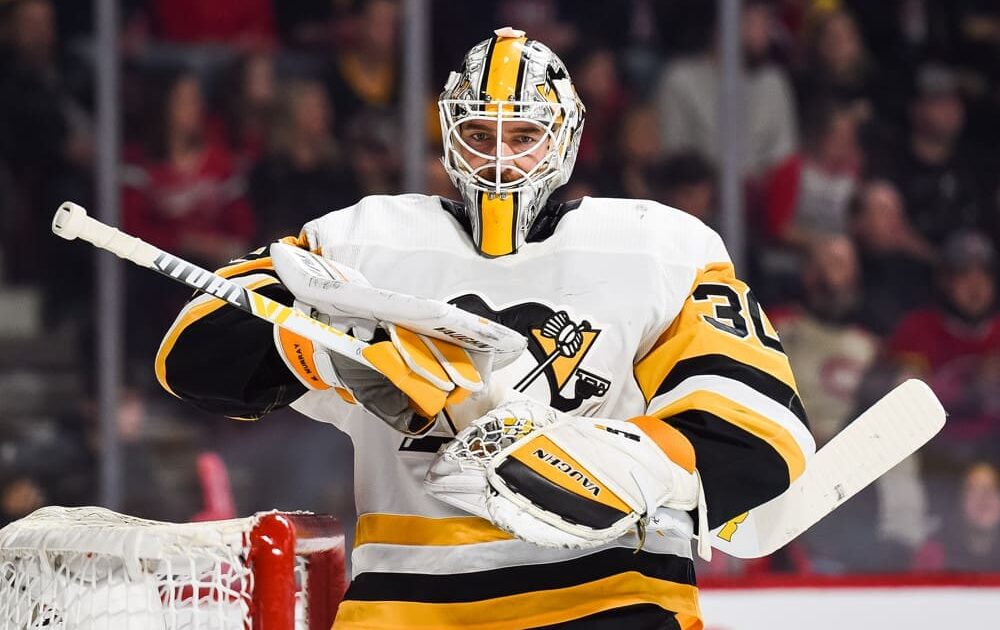Matt Murray Provides Cautionary Tale for NHL GMs

Matt Murray wasn’t just the Pittsburgh Penguins’ goalie of the future in the middle of the last decade.
He was the guy who had earned two Stanley Cup rings before he got on a first-name basis with razor blades and shaving cream, who figured to team up with promising prospect Tristan Jarry to solidify the Penguins at his position for many winters.
Murray’s productivity and potential were so great during his first two seasons in the NHL that then-GM Jim Rutherford never balked at the idea of parting with Marc-Andre Fleury, the best goaltender in franchise history, to cement Murray’s place as the Penguins’ go-to goalie.
Hindsight aside, allowing Fleury to go to Vegas in the 2017 expansion draft was perfectly logical (although bribing the Golden Knights with a second-round draft choice to claim him probably was a bit much). He was nine years older than Murray and had a considerably bigger salary-cap hit.
And while Fleury was — and still is — the only Penguins goaltender to earn three Stanley Cup rings, Murray was 2-for-2 when the Penguins parted with Fleury.
And there was every reason to believe that he’d have a real shot at adding to his collection in the years ahead. Murray had, after all, been that good during his first two playoff runs, going 22-9.
He subsequently was 6-6 in 2018, when the Pittsburgh Penguins were eliminated by Washington in Round 2.
Murray went 1-6 during the two springs that followed, and after Montreal upset the Penguins, 3-1, in a best-of-five qualifying-round matchup in 2020 — when Murray was so leaky that Jarry replaced him for the series finale — Rutherford traded him to Ottawa.
Murray hasn’t faced a shot in a playoff game since.
He hasn’t made it into all that many regular-season ones, either.
Mostly because, if a body part is mentioned in Gray’s Anatomy — the medical reference book, not the TV series — Murray probably has missed some playing time because he’s sprained, strained, fractured or concussed it.
He made a total of 45 starts in two seasons with the Senators, going 15-25-3, before then-Toronto GM Kyle Dubas acquired him in 2022.
The Maple Leafs were gambling that Murray could stay healthy and provide stability in a position where it was desperately needed.
He didn’t. On either count.
Murray put up fairly respectable numbers — he went 14-8-2, with a 3.01 goals-against average and .903 save percentage — but adductor, ankle and head issues limited him to 26 appearances.
All of the physical problems would have been enough of a challenge, but Murray had to deal with a mental one, as well, while still with the Penguins. His father’s death in January, 2018 seemed to have a profound and lasting impact on him, although there obviously is no way to measure that.
Obviously, Murray’s medical issues haven’t been the Penguins’ concern for several seasons, but word this week that the Maple Leafs will place him on the Long-Term Injured list put him back on the radar here.
Going on LTIR means Murray will have to sit out at least 10 games and 24 days at the start of 2023-24, and there is considerable speculation that he will spend the entire season there.
While more than a few observers contend that Toronto is doing that strictly to circumvent the salary cap — the Maple Leafs are believed to be about $12 million over the ceiling, and putting Murray and defenseman Jake Muzzin on LTIR will close that gap considerably — it hardly requires a hyperactive imagination to envision Murray having a physical condition that would prevent him from being ready to start the season.
Sure, he backed up Joseph Woll for a playoff game this spring and reportedly was healthy and looking forward to 2023-24 then, but in terms of durability, Murray’s medical history makes porcelain seem like tempered steel.
Murray is only 29, and it’s conceivable that he could someday return to being the franchise anchor the Pittsburgh Penguins believed him to be six years ago.
But until that happens, he will serve as a reminder to NHL GMs about the perils of counting on even the most promising player to be a major, long-term contributor.
Categorized:Penguins